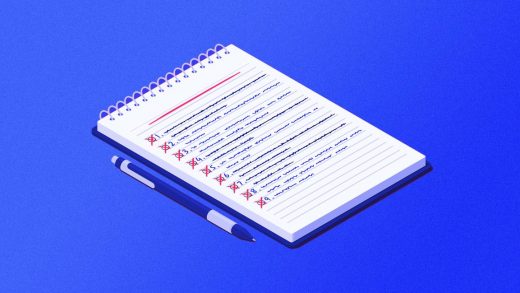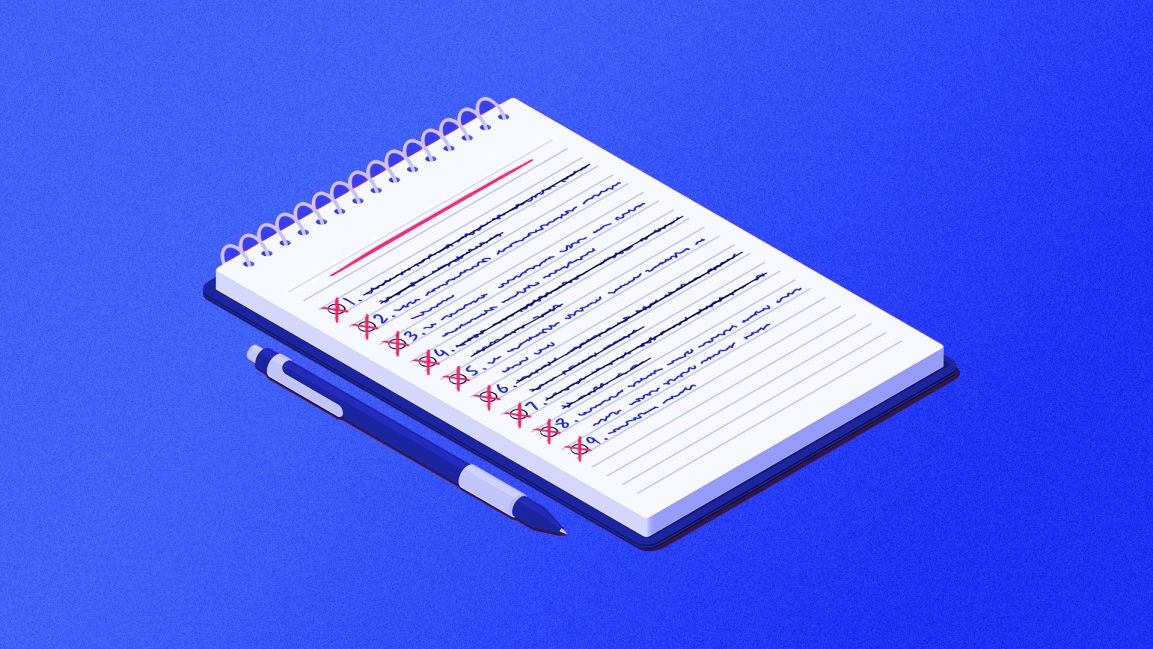I tried making a ‘to-don’t list’ instead of a to-do list. Here’s what I learned
During the course of this remote-work experiment, I’ve noticed in myself a waning of energy. Slowly but surely the afternoon may descend into moments of low motivation and sluggishness, if I don’t seek out some “wake-up” activity, such as doing 50 jumping jacks or (more commonly) glugging down a mug of coffee. In recent weeks, I’ve been trying out various productivity methods like the Pomodoro Technique and time-blocking, but I decided to test-drive another technique.
For the last two weeks, I’ve been using “to-don’t” list, which sounds like an inverse to a to-do list, but is a bit more exacting. In essence, the list is a curated collection of activities that can derail your energy and motivation. They’re often alluring but end up creating a distracting spiral, sapping you of your most productive hours.
When creating a “to-don’t list,” look at what works for you and tailor it. Practicing self-awareness is a place to start, says Elizabeth Grace Saunders, a time management coach and regular Fast Company contributor.
She recommends beginning the exercise with an end-of-the-day review, at least when you first start: “You can reflect back on your day during a daily wrap-up. In this time, you can look at what you accomplished and what didn’t get completed. And you can also evaluate the activities that you did that weren’t part of your plan. You can ask yourself: Was that worth it? Did I enjoy it? Did I feel frustrated or derailed? By keeping track of your own feelings about the choices you made, you can start to discover what is or isn’t healthy for you.”
This is what I took away from my two-week experiment:
The list served as a reminder of all the tiny things that take up my time
Similar to a friend who doesn’t just buoy you with compliments, but offers their “tough-love” feedback when you need it, my to-don’t list keep me focused on the most significant parts of my day by serving as an accountability visual.
To start my list, I began thinking about which of my daily activities were not serving me well. Some of these were pretty obvious; some which were sneakily inlaid to my daily schedule. Some of these activities, which I would later invert for my to-don’t list, included not moving for eight hours, spending too much time consuming news, and letting random clutter build up on my desk.
I initially collected these items in a Google Doc, but actually decided to keep my “avoid me” activities to a refreshingly simple format: a piece of lined paper. This separate, tactile medium helped me to not only to separate projects, but also cut-down on my tendency to task-switch between computer windows and applications.
All seven of the directives on my final list were simple things like “Don’t forget to take a break to rest your eyes,” and “Don’t sit in one place for more than one hour.”
At first I was frustrated when adhering to these new rules temporarily disrupted my flow. However, over time, I noticed they truly paid off. I found that I felt less of the usual physical and mental signs of fatigue (i.e. more sustained alertness, less likely to turn to longer breaks). My sense of weariness seemed less pronounced in the afternoon and instead, more aligned with my actual work day.
My to-don’t reminder to guzzle less caffeine helped encourage me to not only consume more water, but also helped to trigger a mental note to disconnect from my screen and take a moment to breathe.
I noticed when certain tasks were taken out of my routine, their value (or more so, lack of value) was more apparent. For instance, throughout the day, I usually regularly refresh my social media news feeds. This practice keeps me up-to-date on the latest headlines, which can be useful for my job, but the process often means I waste time viewing many similar stories, all published by different outlets. The process was inadvertently draining my energy and taking too much of my time.
So, instead of jumping on each exclamatory headline, I restricted myself to reviewing news for only 10-minute periods, forcing myself to skim for similar keywords and making a mental note to skip over repetitive information.
The list helped me wrangle my energy and focus
While working with a “to-don’t” list, I noticed I was more naturally aware of what times of day and which areas I was pouring more of my bandwidth into. With the awareness of which activities were not adding to my day, I was able to identify pockets where my energy was at its best and my focus at its sharpest—for me that’s typically during the morning and sometimes, a last-minute jolt before the end of my work day.
According to Saunders, this awareness can be particularly useful for those who are feeling the strain of too much time working from home or those who just would like a novel approach to scheduling. “I think a to-don’t list is helpful if you’re working remotely,” she says. “A lot of times our minds wander because we’re simply bored and seeking stimulation. Knowing what your unhealthy patterns may be when you’re bored, and preemptively limiting them, can help you to make better choices in the moment. ”
Further, I noticed the more mundane, non-work-related tasks on my to-do list often led me to waste time and energy. Certain activities, like making appointments or restocking a household item through an online order, served my schedule better if they were automated or completed in a batch. Otherwise I found myself going down a rabbit-hole doing a spontaneous home-cleaning, or sinking into an overly leisurely break after completing a non-work chore.
With my list of “no-no’s” placed physically in front of me, I was able to more effectively monitor unhealthy habits, which I originally thought were completely productive. This included spending too much time in my inbox. The examination lead me to take up more intentional, “10-second skims” of messages, and only respond to the relevant ones. I also noticed my “to-don’t list” helped me cut back on task-switching, further emphasizing the toll hopping around among responsibilities can have on your resolve and focus. By catching sight of my list, I was able to save myself from an afternoon of only half-completing tasks.
The list lead me to more wins and fewer afternoon slumps
By frequently referring to this list of avoidable behaviors, I not only refined where I put my energy, but also increased my feeling of accomplishment at the end of the day. Something can be said for being able to look over your list of “to-don’t’s” and not crossing them off, but congratulating yourself on the self-control needed to follow them. I felt less defeated, since I didn’t have an entire collection of tasks to address by late-afternoon. Moreover, my “to-don’t” bulletin made me aware of why it was I hit a wall. For example, one day, I was feeling especially drained and looked over my list, and saw I had failed to address number three on my list: “Don’t go overboard on carbohydrates at lunch.”
Saunders says that a to-don’t list is helpful because it can pull us out of a rut of unproductive activities, many of which we may unconsciously repeat. “Sometimes we do these activities because they’re easy, tempting, or simply a habit, but they’re [usually] not satisfying.”
For many remote workers like myself, a more constrained and less socially engaging work space has increased the time I spend online, even when I tell myself, “Diana, you’re off the clock now.” In this way, a to-don’t list’s help set guardrails between my work and leisure time, further adding to the technique’s benefits.
Saunders agrees this blurring of boundaries is one reason to turn to a “to-don’t list” for intervention. She says, “I’ve heard many [people and clients] say that they’ve cut back dramatically on social media and news in the last few months and all feel much better. With the influx of information so readily available on many things [from] our day-to-day lives, we have to learn where and how to set limits.
The limitations of a to-don’t list
Overall, I found the to-don’t list to be a helpful experiment in that it helped me cherry-pick the bad behaviors in my day. However, it left me a bit wanting for the bigger priorities that keep me focused on and aware of my goals. I could see a to-don’t list serving as a friendly list of reminders for when my responsibilities were piling up, and when both avenues of work and life were feeling particularly chaotic. Since it doesn’t change dramatically from week to week, it won’t really replace your to-do list, but it can help you identify and streamline your daily priorities.
(38)



